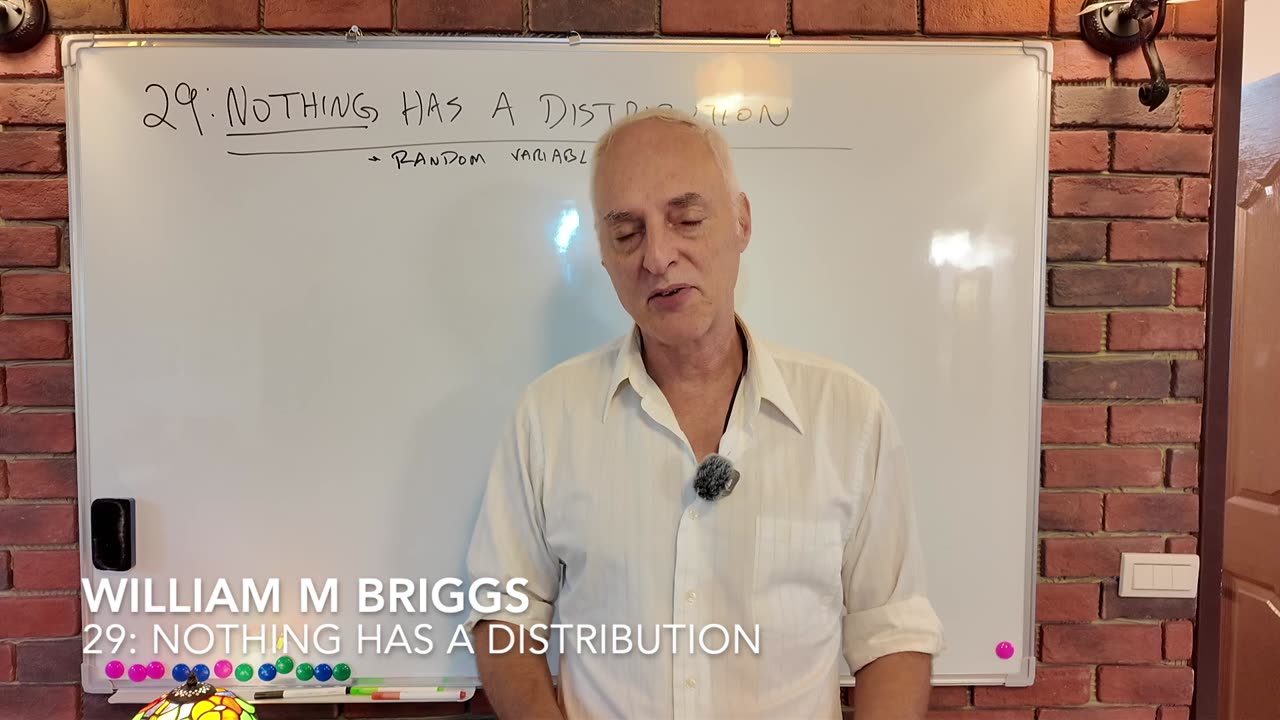Premium Only Content

Class 29: Nothing Has A Distribution
Lesson 29: Nothing Has A Distribution
DO TO CIRCUMSTANCES, I'VE HAD TO CHANGE THE SETTING FOR A WEEK OR TWO.
But I made a mistake in the book and didn't correct in the video! I correct it here.
We'll talk about this many times. Here it is simple. Suppose Sally takes a college class that is graded on a scale 0, 1, 2, 3, 4, and no other numbers are possible. She takes one class. We deduce her GPA could be, and only could be, 0, 1, 2, 3, 4. There are no other possibilities.
Now suppose she takes two classes. The GPA possibilities are now 0, 0.5, 2, 2.5, ..., 4. There are no other possibilities. The mistake in Uncertainty is assuming each of these is equally likely. They are not, given G. Given G' = "The possibilities are 0, 0.5, 2, 2.5, ..., 4", which is not G, the probabilities of each GPA are equal. Given G, they are not. Because, for instance, there are two ways to get 0.5, a fact we deduce from G, but not G'. If you read the book substituting G' in for G, all works. Homework is to figure right correct probabilities.
Since nothing has a probability, and probability does not exist, nothing can have a distribution, either. There are no "means", "standard deviations" and the like, as "true" values: these words are anyway equivocal. It turns out probabilities are models!
All questions will be answered in the following Monday's lecture.
Written lecture:
https://www.wmbriggs.com/post/53989/
https://wmbriggs.substack.com/p/151636120
Jaynes's book (first part): https://bayes.wustl.edu/etj/prob/book.pdf
Permanent class page: https://www.wmbriggs.com/class/
Uncertainty & Probability Theory: The Logic of Science
-
 4:49:04
4:49:04
HogansAlleyHero
17 hours ago💥CHASING DOPAMINE💥✅TRUMP SAYS BATTLEFIELD IS THE BEST✅
41.8K3 -
 1:57:40
1:57:40
MattMorseTV
7 hours ago $10.90 earned🔴Trump just SHATTERED the PROJECTIONS.🔴
54.3K50 -
 2:32:19
2:32:19
megimu32
6 hours agoOTS: From Star Search to Superstardom
38.7K4 -
 1:56:21
1:56:21
Joker Effect
5 hours agoInterviewing GREENMAN! Looks like he is coming to Rumble! Let's give him a warm welcome! REAL TALENT
23.7K1 -
 1:07:21
1:07:21
Anthony Rogers
12 hours agoEpisode 380 - Is Pain All In Your Head?
16.6K3 -
 1:46:17
1:46:17
Glenn Greenwald
9 hours agoGlenn Takes Your Questions on Censorship, Epstein, and More; DNC Rejects Embargo of Weapons to Israel with Journalist Dave Weigel | SYSTEM UPDATE #505
118K8 -
 3:26:34
3:26:34
Jokeuhl Gaming and Chat
11 hours agoHelldivers 2 - Spreading Democracy w/ Ryker
13.2K1 -
 27:47
27:47
Stephen Gardner
6 hours ago🚨BREAKING: Trump FURIOUS Over Kamala’s Latest Move – SHOCKING Details!
18.7K81 -
 8:00:13
8:00:13
Dr Disrespect
15 hours ago🔴LIVE - DR DISRESPECT - GEARS RELOADED GLOBAL LAUNCH - CRUSHING LOCUST
114K14 -
 4:56:09
4:56:09
Reolock
7 hours agoWoW Classic Hardcore | One level at a time
4.06K